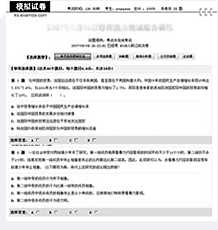试卷简介
试卷预览
Passage 1
Questions 1 to 5 are based on the following passage.
Stephen Crane is probably best known for his American Civil War novel, The Red Badge of Cowrage,a story of the reactions of an inexperienced soldier to the horrors of war. He,however,, was chiefly a writer of short stories,, the most noteworthy (值得注意的) of which are “The Blue Hotel,” “The Bride Comes to Yellow Sky,” and “The Open Boat.”
Crane lived during the last three decades of the nineteenth century and, ,like many artists of his time, rejected traditional, romantic themes and wrote about what he saw around him in the most realistic terms—the cruel and violent, as well as the gentle and humorous.
Robert E. Spiller, one of Americans leading literary historians, believes that modem American fiction was bom with Stephen Crane's work. Though the total volume of his work may be too slender (不足的) to qualify him as a first-rate writer, he is still an important figure in the American fiction of the nineteenth century.
Son of a Methodist minister, Crane was bom on November 1, 1871, in Newark, New Jersey, the youngest of 14 children. His childhood was a happy one. In school, he was more interested in baseball than in his studies, and at one time he considered becoming a professional ball player. But the career of a writer was his natural choice, and after two years of college, he went to New York to write. There he lived for five hard years, enduring much illness and achieving no success in his work.
In New York, Crane made a small amount of money by writing for newspapers, but his real writing at this time was his first novel,Maggie:A Girl of the Streets. Unlike other writers who sentimentalized(情绪化的)or moralized about what they saw, Crane accurately told of the cruelty and poverty of city life. He published Maggie at his own expense, but it did not sell well. At that time, the story was considered so shockingly realistic that the publisher refused to identify himself with the book.
Meanwhile, half-starved and often ill, Crane continued to write. He completed The Red Badge of Courage in 1893 when he was only 22 years old. It was published two years later and quickly became a best-seller. Suddenly Crane found himself a famous young man. Unfortunately, he made only $100 from the book.
All his writings cannot, of course, be considered equally good. But Crane 's vivid impressions of life, his keen insight, and his fine distinctive style, colorful and forceful, provided a pattern for later writers. He gave the naturalistic fiction the characteristic form which was later used by Ernest Hemingway, William Faulkner, John Steinbeck, and a host of others.
What is this passage mainly about?
A.Stephen Crane’s life and works.,
B..The portrayal of reality in novels.,
C.American writers of the early 19th century.,
D.The influence of religion on Stephen Crane.
Maggie: A Girl of the Streets is a novel that deals with ______.
A.soldiers,
B. urban life,
C. moral values,
D. newspapers
According to the passage, The Red Badge of Courage is ______.
A.naturalistic,
B. romantic,
C.sentimental,
D. modernistic
It can be seen from the passage that Crane is regarded mainly as ______.
A.a romantic writer,
B.a great novelist,
C.a newspaper reporter,
D.a short story writer
Crane's novel The Red Badge of Courage was______.
A.profit-making,
B. totally rejected,
C. well received,
D. prize-winning
Passage 2
Questions 6 to 10 are based on the following passage.
The history of the word “creole” itself dates back to the slave trade. After slaves had been gathered from many parts of Africa, they were imprisoned in West African camps,euphemistically (委婉地)called “factories” for “processing” before being shipped out to “markets.” The managers of the factories took great care to separate slaves who spoke the same tribal language, thereby lessening the danger of revolt among slaves who could communicate with one another. And further separation on the basis of language was made by the purchasers in the New World. As a result, the only tongue the slaves had in common was a pidgin that originated in West Africa and developed in the colonies to which they were sent. These pidgins became entrenched (根深蒂固) ,and after a generation or two they began to expand to meet the needs of the slaves' way of life. The slaves' new language became known as creole,a French word meaning “native” which in turn was derived from Portuguese.
Nowadays “creole” refers to any language that developed from a pidgin by expansion of vocabulary and grammar and became the mother tongue for many speakers in a community. The largest center of creole languages today is undoubtedly the Caribbean area, with more than six million speakers. Several million additional people speak creoles in West Africa, South Africa, and Southeast Asia, and probably another three million people around the world use various pidgin languages. Clearly, pidgin and creole are not rare or isolated phenomena; they number more speakers today than do such languages as Dutch, Swedish, or Greek.
What is the purpose of writing this passage?
A.To trace the history of the word “creole.”,
B.To account for the variety in slave languages.,
C.To list all kinds of pidgin languages in the world.,
D.To describe how the slaves were treated in the New World.
Why did a pidgin language arise among the slaves?
A.Slave-owners did not understand pidgin languages.,
B.Slaves had to speak with each other in different languages.,
C.Slaves refused to learn English, the language of their oppressors.,
D.Slave-owners forced their slaves to abandon their native languages.
The 1st paragraph is developed in relation to______.
A. process,
B. comparison,
C. space,
D. time
The word “creole” as described in the passage originated from______.
A. English,
B.Portuguese,
C.Swedish,
D.an African dialect
The word ''nowadays" at the beginning of the 2nd paragraph is used to______.
A.signal an example,
B. introduce an event,
C.establish a transition,
D. draw a conclusion
Passage 3
Questions 11 to 15 are based on the following passage.
Willa Cather once said: “When people ask me if writing has been a hard or easy road, I always answer with the quotation, 'The end is nothing; the road is all.' That is what I mean when I say writing has been a pleasure. I have never faced the typewriter with the thought that one more chore had to be done."
Like most authors, Willa Cather did not write books for the money that they brought her, but rather for the pleasure that came in writing them. Her works were, like her, sturdy and simple. They were full of the vigor of her pioneer days in Nebraska, where she grew from childhood to young womanhood.
Born near Winchester,Virginia,on December 7,1873, Willa Cather moved with her family to Webster County, Nebraska, in 1883. There her father fanned for seven months before moving the family into neighboring Red Cloud, a fast developing town of 2,500 people. At Red Cloud, Mr. Cather gave up farming and opened an office dealing in farm loans and mortgages. Young Willa, with reddish-brown hair and blue eyes, lived in that small prairie town from 1883 to 1896.
At that time, Nebraska was still a frontier state, having joined the Union only a few years before in 1876. It was a land of bitter winters, burning summers, endless prairies,and far-flung (分布广的)sod houses—houses made of blocks of dirt because there were no trees for lumber. Cather’s childhood was spent in this place, visiting and playing with other children, almost all of whom were of Swedish, Danish, Norwegian, German, French, Russian, or Czechoslovakian descent. She wrote later about the parents of these children.
Watching these pioneers on the Nebraska prairie created in Cather a lasting affection for the qualities of courage,integrity (正直),and strength of character shown by these frontier people. Later these same people would appear as characters in her books. She also developed a deep love for the treeless land of the Great Plains with its wild flowers, wheat fields, and rivers.
What does the sentence “The end is nothing; the road is all” in the 1st paragraph most probably mean?
A.Writing is a hard road to take.,
B.Writers have many chores to do.,
C. Cather experienced many failures.,
D. Cather enjoyed the process of writing.
Where did Cather spend most of her early years?
A. In Webster County.,
B. In a small town.,
C. Near Winchester.,
D. On a big farm.
What is special about Cather’s childhood?
A.She was good at organizing children.,
B.She enjoyed travels to other countries.,
C.She was used to the extreme weathers.,
D.She played with children from immigrant families.
According to the passage, one element that might NOT appear in her novels is______.
A. the frontier life,
B. virtues of the pioneers,
C. the love for city life ,
D.. scenes of the Great Plains
What does the passage mainly discuss?
A.Life in the American West. ',
B.Cather’s Virginian ancestors.,
C.European immigrants in Nebraska.,
D.The influence of Nebraska on Cather,s writing.
Passage 4
Questions 16 to 20 are based on the following passage.
In the American colonies there was little money. England did not supply the colonies with coins and it did not allow the colonies to make their own coins, except for the Massachusetts Bay Colony, which received permission for a short period in 1652 to make several kinds of silver coins. England wanted to keep money out of America as a means of controlling trade: America was forced to trade only with England if it did not have the money to buy products from other countries. The result during this pre-revolutionary period was that the colonists used various goods in place of money: beaver pelts (生皮),Indian wampum (贝壳珠), and tobacco leaves were all commonly used substitutes for money. The colonists also made use of any foreign coins they could obtain. Dutch, Spanish, French, and English coins were all in use in the American colonies.
During the Revolutionary War, funds were needed to finance the war, so each of the individual states and the Continental Congress issued paper money. So much of this paper money was printed that by the end of the war it was virtually worthless. As a result, trade in goods and the use of foreign coins still flourished during this period.
By the time the Revolutionary War had been won by the American colonists, the monetary system was in a state of total disarray. To remedy this situation,the new Constitution of the United States, approved in 1789, allowed only Congress to issue money. The individual states could no longer have their own money supply. A few years later, the Coinage Act of 1792 made the dollar the official currency of the United States and put the country on a bimetallic standard. In this bimetallic system, both gold and silver were legal money, and the rate of exchange of silver to gold was fixed by the government at sixteen to one.
According to the passage, what happened during the Revolutionary War?
A.A lot of paper money was issued.,
B.American money replaced trade in foreign coins.,
C.Individual states were not allowed to issue money.,
D.The Continental Congress issued gold and silver coins.
Which of the following is closest in meaning to the word “disarray” in the last paragraph?
A. Dismissal.,
B. Confusion.
C. Stability.,
D. Independence.
What does this passage mainly discuss?
A.The shortage of money in colonial American.,
B.The effect of the Revolutionary War on American money.,
C.The American monetary system of the 17th and 18th centuries.,
D.The English monetary policies in the Massachusetts Bay Colony.
The Massachusetts Bay Colony was allowed to make coins ______.
A.for a short time during one year,
B.throughout the seventeenth century,
C.continuously from the start of the colony,
D.from 1652 until after the Revolutionary War
Which of the following is NOT mentioned in the passage as a substitute for money during the colonial period?
A. Wampum.,
B. Cotton.,
C. Tobacco leaves.,
D. Beaver furs.
Passage 5
Questions 21 to 25 are based on the following passage.
The three main types of secondary education in the US have been provided by the Latin grammar school, the academy, and the public high school. The first of these was a colonial institution. It began in New England with the establishment in 1635 of the Boston Free Latin School. The curriculum consisted mainly of the classical languages, and the purpose of this kind of school was the preparation of boys for college, where most of them would be fitted for the ministry.
The academy began in the early 1750s with Benjamin Franklin's school in Philadelphia. It extended generally to about the middle of the nineteenth century, except in the southern states where the public high school was late in developing and where the academy continued to be a principal means of secondary education even after 1900. The academy was coeducational, meaning open to girls as well as to boys, and it provided a wider curriculum than the Latin grammar school had furnished. It was designed not only as a preparation for college but also for practical life in commercial and business activities. Although its wide educational values were evident and are recognized as important contributions to secondary education in the country, the academy was never considered a public institution as the public high school has come to be.
The public high school had its origin in Massachusetts in 1821 when the English Classical School was established in Boston. In 1827, that state enacted the first state-wide public high-school law in the US. By 1840, there were perhaps a dozen public high schools in Massachusetts and many in other eastern states; by 1850, they were also to be found in many other states.
Just as the curriculum of the academy grew out of that of the Latin grammar school, so the curriculum of the public high school developed out of that of the academy. The public high school in the US is the repudiation (声讨)of the aristocratic and selective principle of the European educational tradition. Since 1890,enrollments in secondary schools, mainly public high schools, have practically doubled in the US every ten years.
What does the passage mainly discuss?
A. Franklin’s contribution to education.,
B.The educational reform in American history.,
C.The history of secondary education in the United States.,
D.The importance of secondary education in American life.
According to the author,Franklin’s school,as distinguished from the Latin grammar school, was______.
A.inferior in quality,
B. coeducational,
C.more academic in nature,
D. more specialized
In the southern states, the principal means of secondary education even after 1900 continued to be______.
A.the Latin school,
B.the academy,
C.the classical language school,
D.the public high school
The year 1827 marks______.
A.the founding of the Latin grammar school in Boston,
B.the furnishing of a wider curriculum in Massachusetts,
C.the establishment of the English Classical School in Boston,
D.the enactment of the first state-wide public high-school law
What is the earliest secondary school in the United States?
A.The public high school.,
B.Benjamin Franklin’s school.,
C.The English Classical School.,
D.The Boston Free Latin School.

 最新推荐
最新推荐
 相关试卷
相关试卷

 原创试题专区
原创试题专区 开通学校服务
开通学校服务






